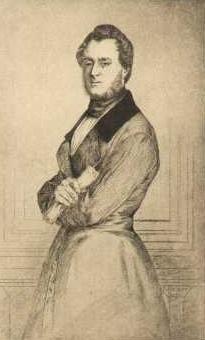Adolphe Schneider
| Adolphe Schneider | |
|---|---|
 |
|
| Born |
François Antoine Adolphe Schneider 23 October 1802 Nancy, Meurthe, France |
| Died | 3 August 1845 (aged 42) Creusot, Saône-et-Loire, France |
| Nationality | French |
| Occupation | Industrialist |
Adolphe Schneider (23 October 1802 – 3 August 1845) was a French financier and industrialist who developed a major metalworking enterprise at Le Creusot, the parent of today's Schneider Electric.
Adolphe Schneider was born in Nancy, France, on 23 October 1802. He was the son of Antoine Schneider (1759-1828), Châtelain de Bidestroff, and Catherine Duran. His cousin was Antoine Virgile Schneider (1779-1847), who was known for his military service in Greece. Virgile married a Polish heiress who brought a considerable dowry. He was elected a deputy for Sarreguemines in 1834, became minister of war and was involved with construction of the fortifications of Paris.
In 1821, at the age of nineteen, Adolphe Schneider entered the Seillière bank. Schneider had been recommended to François Seillière by his cousin Virgile. Seillière was from a Catholic family from Lorraine that had moved to Paris. The bank specialized in helping companies involved in iron-making and metallurgy such as Ignace-François de Wendel. Schneider quickly showed he had a strong business sense with exceptional qualities of listening, understanding, analysis and improvisation. In 1829 Seillière began to give him a share in the profits from supplies of wool, wheat and wood from the north and from marine insurance.
In 1830 Schneider was the bank's agent with the French expeditionary force to Algiers, for which the bank was providing supplies. Schneider met the army's needs from Spanish suppliers, who were cheaper than the French. The project was a great success for the bank. Schneider received a 2% commission on all the merchandise, which gave him enough capital to go into business on his own account as a cloth merchant. On 7 July 1831 he married Valérie Aignan (1812-1861) in Paris. They had three children: Camille, Marie and Paul Henry.
Around this time Schneider formed a relationship with the owners of the Le Creusot ironworks, and loaned them money. The works at Le Creusot had been founded fifty years before by a company partly owned by King Louis XVI of France. Despite an investment of 30 million francs, the works had never prospered. Le Creusot went bankrupt and was sold at auction in 1835 for 1,850,000 francs.
Adolph's younger brother Eugène Schneider had begun work as a clerk in Reims, then joined his brother at the Seillière bank. In 1827 the baron de Neuflize employed him as manager of a forge near Sedan, a position he held for nearly ten years. In 1835 Schneider obtained financing and acquired the works at Le Creusot from the purchaser at a premium of one million francs. Adolphe brought in Eugène to run the works while he handled finance and sales.
...
Wikipedia
